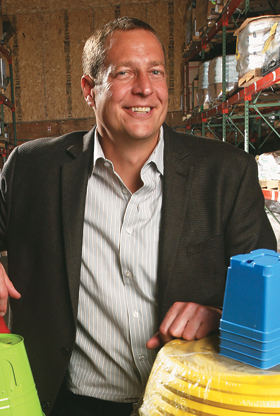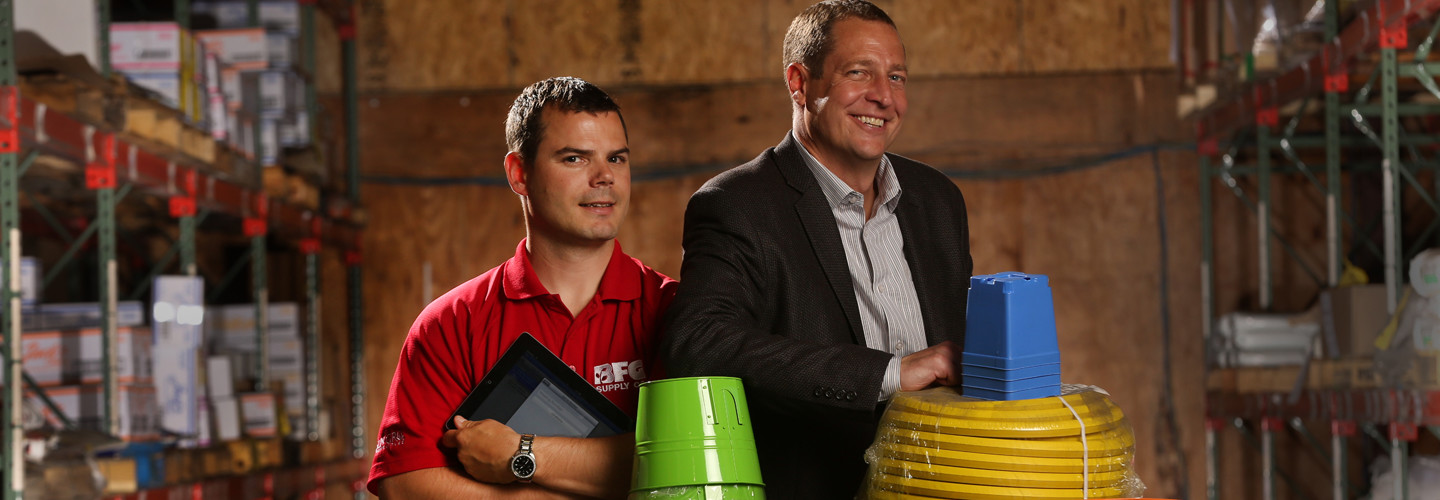How Technology Helps a Horticultural Giant Grow
Many companies consider technology a means to support their business functions. But BFG Supply — a horticultural supplies distributor based in Burton, Ohio, with 13 branches across the country — sees things differently.
For BFG, technology is a strategic asset that separates the company from its competitors.
“In our industry, we feel as though we have by far the best strategy and execution of technology, in an innovative sense that directly impacts our customer,” says Tim Gallagher, BFG’s vice president of technology and e-business. “Through standard off-the-shelf communications and custom technologies, we provide products and solutions to our customers. It’s a differentiator for us, and it’s really a competitive advantage.”
Rob Glockner, the company’s president and CEO, says the Cisco Systems unified communications and telepresence technology that BFG deployed with CDW’s assistance completely transformed the company’s communications.
Today, all 300 of BFG’s employees — from top executives to warehouse and counter workers — have access to video conferencing. Armed with video-enabled phones, employees from distant branches, who have been talking to each other for a decade or more via standard voice calls, can now see one another. Top executives from any location can meet as if they were in the same room. The company can recruit and hire better workers because location is no longer a barrier to effective communication or productivity. In addition, employees at newly acquired companies are much more easily absorbed into BFG’s corporate culture now that they have the video option, Glockner says.
“We felt a strong need to stay on top of the technology, and, as geographically dispersed as we are, we decided that business travel wasn’t enough to keep us together,” he says.
“The old-fashioned audio conference calls were discouraging people from communicating,” says Glockner. “Email is a fine tool, but you can’t always read a person’s tone in an email. With telepresence, you can see a person’s body language. It’s like having the remote employees at the end of the conference room.”

Photo: Kyle Keener
“Email is a fine tool, but you can’t always read a person’s tone in an email. With telepresence, you can see a person’s body language. It’s like having the remote employees at the end of the conference room.” — Rob Glockner, president and CEO, BFG Supply
Competitive Advantage
The unified communications system helps BFG offer better customer service than its competitors. For example, when a customer comes into a BFG location, the UC presence function can let a BFG associate at the counter know if a specific product specialist is available. If the specialist is available, the system can quickly connect them via a video call. If the specialist isn’t in, the system can connect the customer to the next-best person available in that BFG branch or a product specialist at another branch.
“The technology is a true difference-maker in every sense of the word,” Gallagher says. “Every conversation we have, we feel like the person is sitting right in front of us. I have candid conversations with my direct reports who are in four different locations, and I have people who work from home, and when you call them, you feel like they’re sitting there with you. So video conferencing does make a massive difference in your culture, in your ability to make sure that people understand what the need is. Because while there is no replacement for direct one-on-one communication, this really is a close second.”
BFG has more than 240 video-enabled phones distributed throughout the company. The customer counter in each branch has a Cisco 8941 video phone, as does each warehouse. Product specialists and customer service people use Cisco 8945 video phones at their desks. The company also has four room-based telepresence setups: one in its Burton headquarters and others in St. Paul, Minn.; Harrisonburg, Va.; and Grand Rapids, Mich. The company uses Cisco C40 and C20 telepresence units. BFG also uses portable EX90 telepresence kits in Kittanning, Pa., and Baltimore, which the company plans to move around as it opens other branches across the country.
Glockner says telepresence offers a major boost to BFG’s relationships with vendors. For example, executives from a manufacturer might be visiting the St. Paul branch; but while meeting with BFG’s people there, they could also meet with Glockner in Ohio and other managers throughout the company.
“It shows that we are on top of the technology and are the kind of people they would want to do business with,” Glockner says. “They really like that they can meet with the top people in the company all in one visit.” BFG Network Engineer Doug Wolfe says the technology helps bring people together during acquisitions too.
“We’ve gone through a large acquisition where we brought on a company with two locations,” Wolfe says. “Many of those people had been working together for up to 20 years and never met each other. Now, they can.”
The Unified Communications Advantage
Gallagher says the addition of other unified communications technologies is as important as the video conferencing and telepresence features. For years, the company deployed a Voice over IP system that lowered long-distance costs and even offered voice mail in email. But those features were the limit of what the system could offer. Now, BFG uses presence, instant messaging and softphones, as well as video. These technologies speed up communications and help the company’s employees work faster and smarter.
The UC environment even helped BFG accelerate development on its recent website upgrade, Gallagher says. The system makes it easier for the staff to schedule, confirm and conduct meetings, so the web team can develop specific features on the site within a few hours.
Gallagher notes a clear advance in BFG’s collaboration capabilities:
“From conception to execution, an idea is generated, and we’ve got four locations providing direct feedback over a high-definition telepresence link while the web team is presenting either wireframes or general concepts,” he says. “Because of that capability, we can get decisions made and get our ideas to market much, much faster.”
Wolfe says BFG has also rolled out Cisco’s Jabber voice client for iOS and Android smartphones. Using the Jabber client, mobile workers can access the corporate phone network. The client lets them use a smartphone the same way they would a desk phone. They can put calls on hold and even access the corporate phone directory. “For now, it’s audio only, but it gives our people another option,” Wolfe says.
Don Barker, the CDW unified communications solution architect who worked with BFG on its UC and telepresence project, says the company has seen the value of IP telephony for years. That value has increased as the technology has improved over time.
“In the first wave of IP telephony, companies found cost savings and productivity value in connecting IP phones. Then, in the second wave, they connected branch offices and saved on long distance,” Barker explains. “Today, with the UC concept, companies can take communications applications and layer them over the IP telephony technology.”
Gallagher says CDW’s in-depth knowledge of the UC technology and the business assurance process greatly impressed him during the deployment.
“Don Barker was one of the best systems engineers I’ve ever worked with,” Gallagher says. “You could tell he really cared, and you don’t see that every day. We also appreciated that CDW identified potential hurdles before they ever became a problem. It’s that presales process, which is why Cisco recommended we take a hard look at CDW.”
Barker says he focuses on Cisco deployments every day. “I live and breathe Cisco UC all day,” he says. “And that’s a large advantage to our customers.”
In fact, Gallagher says that while the Cisco technology is more complex to install, the vast benefits it delivers to the company in terms of enhanced communications are worth the effort.
“I wouldn’t go so far as to say that any Cisco implementations are plug-and-play,” Gallagher says. “But with that level of complexity comes functionality, and today I feel strongly that we have functionality that other systems cannot provide. So because of that, we rely heavily on the CDW team to do the implementation and the training of our administrative team.”
With CDW’s help, Gallagher has implemented technology that has utterly transformed the way BFG Supply does business. In providing its employees with the means to communicate more effectively with each other and customers alike, BFG is leveraging a strategic edge in the marketplace that will allow the company to thrive and grow well into the future, right along with the healthy plants its customers are growing.








